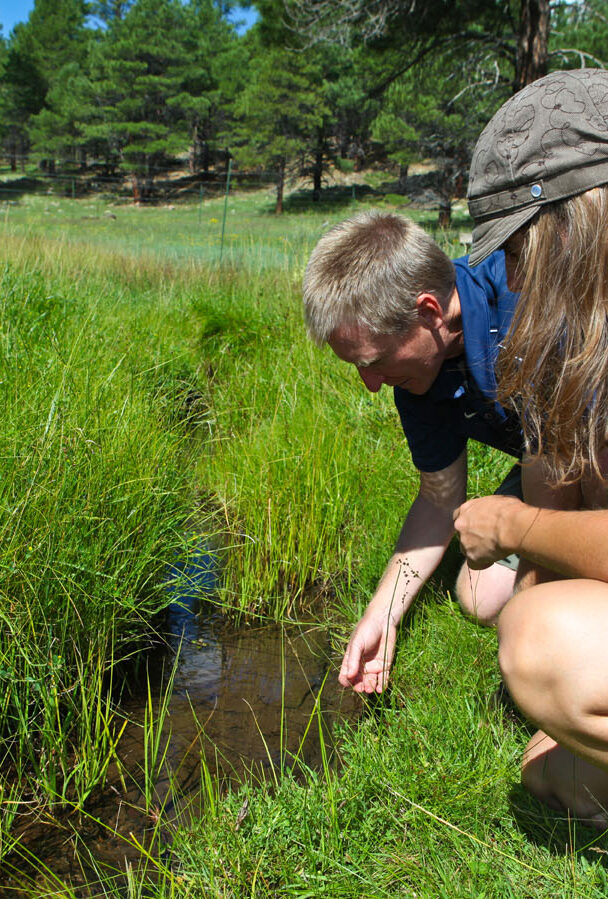SRP and NAU to Study Effects of Forest Restoration
FLAGSTAFF, Ariz. – Scientists say Arizona’s overcrowded forests are affecting the natural processes of a healthy ecosystem. Past studies have shown that much of Arizona’s ponderosa pine forests have hundreds of trees more per acre than existed prior to 1900.
This overstocking has had dramatic impacts on the hydrologic cycle, as well as related impacts to range conditions and wildlife habitat. In addition, where fire was once a welcome visitor to the forest in helping to thin trees and recycle nutrients, fire now is prone to explode into a catastrophic stand-replacing wildfire. The effects of climate change are likely only to make matters worse.
To find out how the forest ecosystem responds to landscape-scale forest-restoration efforts, the Ecological Restoration Institute (ERI) at Northern Arizona University and Salt River Project (SRP) are teaming up in an unprecedented research project through 2013.
Findings from the half-million-dollar study, “Predicting hydrologic and other natural resource responses to restoration treatments and changing climate for the Verde River Watershed,” are expected to help the Forest Service and stakeholders of the Four Forest Restoration Initiative, or 4FRI, make science-based decisions that benefit watersheds in the massive 2.4 million-acre forest-health project across the Mogollon Rim.
“As stewards of the Salt, Verde and East Clear Creek water resources, SRP is tremendously interested in how the 4FRI effort will influence the dynamics of the watershed hydrology, water quality, sediment loads and carbon cycle of the forests,” said Charlie Ester, manager of Water Resource Operations for SRP, the largest provider of water and power to the Phoenix metropolitan area. “This is the nation’s largest forest-restoration effort ever attempted, and from a watershed standpoint it will ultimately impact millions of Arizonans. Our hope is that the research with NAU shows that restoration of the forest ecosystem results in a healthy and properly functioning ecosystem that is more resilient than existing conditions.”
“The ability of Arizona’s forests to provide high-quality water has been compromised by degraded forest health,” said ERI Executive Director Wally Covington, Ph.D., the principal scientist on the project. “In the last century, Arizona’s ponderosa pine forests have become denser because of fire suppression, grazing and past logging practices. Through this study with SRP, we need to better understand how these denser forests impact sublimation of snowfall. Connecting tree canopies intercept snow where it evaporates before reaching the ground. Anticipating there is less snow accumulation and snow retention, what is the impact on stream-flow runoff and groundwater recharge?”
In addition, Covington said excess trees on the landscape are absorbing water that historically would be supporting wetlands. And, overcrowded forests are providing fuel for unnaturally intense wildfires.
“Stand-replacing crown fires, like the Wallow Fire, burn up the vegetation and can make the soil hydrophobic, so it doesn’t absorb water for a period of time after the fire,” said ERI Director of Research and Development Dave Huffman, Ph.D., the co-investigator on the study. “As a result, monsoon rains in the high country following these intense wildfires can produce serious erosion, moving tons of soil, downed logs and ash downstream where they clog up lakes and reservoirs.”
“There are a number of issues with sediment deposits,” said co-investigator Abe Springer, Ph.D., a hydrogeologist with NAU’s School of Earth Sciences and Environmental Sustainability. “One immediate concern is for the health of aquatic organisms when there’s a change in water quality. Another is the sediment build-up in reservoirs. That can impact the water supply by decreasing the ability of the reservoir to store water.”
The NAU-SRP study will involve computer modeling to understand what happens to hydrologic systems and other natural resources such as wildlife habitat and understory vegetation under different forest-restoration treatments through time. Treatments include thinning and prescribed burning to mimic the intensity, frequency and impact of natural fire. Also, it will include a systematic review of published literature on restoration research and compare pre-settlement and future forest scenarios, as well as impacts from crown fires on watersheds using actual fire-severity data from the June 2011 Wallow Fire.
“We have information about historical conditions and restoration treatment responses at scales of about a thousand acres or so, but this is new territory for us,” said Huffman. “Wildfires are operating at the scale of a half-a-million acres, so we need to broaden our understanding of ecosystem function and restoration at similar scales. Simulation modeling is one of our best tools to try to understand climate change and try to get ahead of these issues.”
“All climate models show our mean annual air temperature will warm over the next century by 2 to 5 degrees Celsius. With that comes acceleration of the hydrologic system,” said Springer. “Evaporation and plant-transpiration rates accelerate with warmer temperatures.”
Arizona’s forested watersheds contribute nearly 90 percent of the state’s total stream flow and serve as important recharge areas for large regional aquifers, according to a report by the Water Resources Development Commission.
Findings from the NAU-SRP hydrologic study are expected to have far-reaching implications, helping land managers with large-scale forest-restoration projects across the Southwest.



